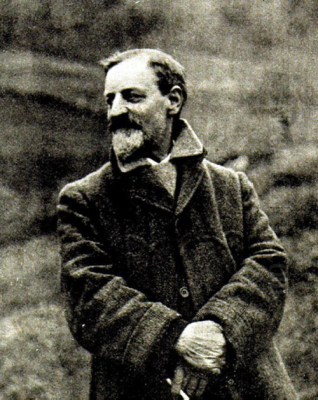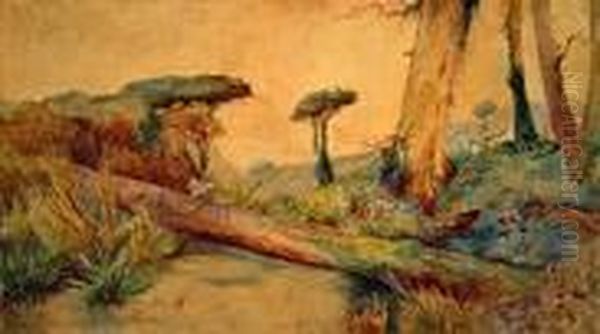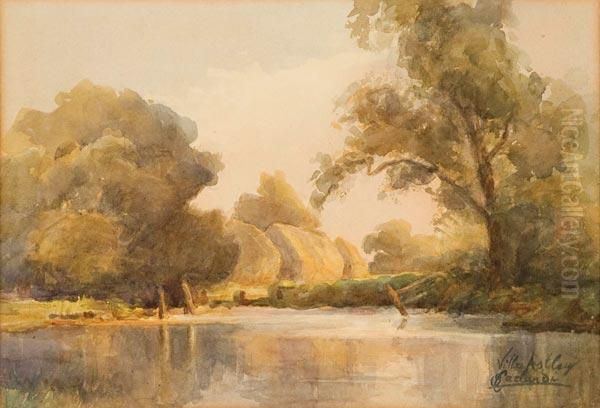
Onorato Carlandi (1848–1939) stands as a significant figure in Italian art history, particularly celebrated for his evocative landscape paintings. An Italian national, Carlandi dedicated his long career to capturing the poetic beauty of the natural world, focusing primarily on the countryside of his native Italy and also finding inspiration in the landscapes of England. Active during a period of transition and dynamism in European art, from the late nineteenth century well into the twentieth, he became a leading voice in the Roman school of landscape painting, leaving behind a legacy of luminous works and a commitment to artistic independence.
A Dedication to Landscape
Carlandi's artistic identity is inextricably linked to landscape painting. He possessed a profound sensitivity to the nuances of light, atmosphere, and the changing seasons. His works are not mere topographical records; they are imbued with a lyrical quality, reflecting a deep connection to the environments he depicted. He famously believed in the importance of inner inspiration guiding the artist's hand, stating, "Nourish the spirit and the mind, and the hand will follow naturally." This philosophy permeated his approach, leading him to seek direct engagement with nature.
His travels informed his art significantly. While the Roman Campagna remained a central theme, Carlandi also spent time painting in England, absorbing the different qualities of light and landscape found there. This cross-cultural experience enriched his palette and perspective, allowing him to develop a versatile yet distinctive style recognized for its poetic sensibility and technical skill, particularly in the medium of watercolor, though he was also proficient in oils.
The Roman Campagna and the "XXV"
The area surrounding Rome, known as the Campagna Romana, held a special allure for artists for centuries. By Carlandi's time, it became a focal point for painters seeking to escape academic constraints and engage directly with nature. Carlandi was not just an observer of this trend; he was a key organizer and protagonist. In 1904, he became a founding member and driving force behind the group known as "I XXV della Campagna Romana" (The Twenty-Five of the Roman Countryside).

This collective was more than just an artistic circle; it represented a philosophy. Its members, who included notable artists such as Ettore Ferrari, the sculptor and painter, and the versatile Duilio Cambellotti, shared a commitment to plein air painting – working outdoors directly from the subject. They sought artistic freedom, often positioning themselves against the more rigid structures of official art institutions and exhibitions. The group's activities often involved excursions into the countryside, where they would paint together, capturing the fleeting effects of light and weather.
Other artists associated with or orbiting this vibrant scene included Enrico Coleman, known for his masterful depictions of the Campagna and its wildlife, Cesare Pascarella, a poet and painter, Alessandro Morani, and Napoleone Parisani. Carlandi's nephew, Pompeo Fabri, also became a member, having learned painting under his uncle's guidance. The spirit of the XXV was one of camaraderie, shared exploration, and a dedication to portraying the authentic character of the Roman landscape.
Artistic Style and Technique
Onorato Carlandi's style evolved throughout his career but consistently displayed certain core characteristics. He is often noted for his rich use of color and a relatively free, sometimes bold, application of paint. While rooted in the naturalist traditions prevalent in the nineteenth century, his work also shows an awareness of Impressionist currents, particularly in its emphasis on capturing light and atmosphere. His brushwork could range from delicate and descriptive, especially in his watercolors, to more vigorous and expressive strokes in his oil paintings.
His mastery of watercolor was particularly esteemed. He played a significant role in the "Associazione degli Acquarellisti Romani" (Roman Watercolorists Association), serving in leadership positions. This group, inspired by similar societies in Britain, aimed to elevate the status of watercolor painting in Italy. Figures like Ettore Roesler Franz were also prominent in this milieu. Carlandi's watercolors often possess a remarkable luminosity and transparency, effectively conveying the damp air of England or the brilliant sunshine of the Italian countryside.
In his oil paintings, such as scenes painted near Tivoli later in his life featuring cypress and poplar trees, one can observe a bolder palette and a style leaning towards Impressionism. These works, some housed in collections like the Louis B. and Eleanor Deane Swan Audigier Art Gallery, demonstrate his ability to adapt his technique while maintaining his focus on the essential spirit of the landscape. He sought to convey not just the appearance of a place, but the feeling it evoked.
Representative Works
Carlandi's extensive oeuvre includes numerous landscapes that exemplify his artistic vision. Among his notable works are:

Passeggio con Alberi (Landscape with Trees): A watercolor on paper, showcasing his delicate touch and ability to capture a serene natural setting.
Roman Landscape: A larger watercolor, demonstrating his skill in rendering the expansive vistas and specific light conditions of the area around Rome.
Nel Bosco (In the Woods): An oil painting capturing the intimacy and atmosphere of a woodland scene.
Sunset in the Castelfusano Pine Forest (Tramonto nella Pineta di Castelfusano): An oil painting likely highlighting his interest in the dramatic effects of light at different times of day.
Il Soratte: An oil painting depicting the distinctive silhouette of Mount Soratte, a recurring landmark in the Roman Campagna, showcasing his ability to handle large-scale compositions.
Paesaggio (Landscape): Another significant oil work, further emphasizing his dedication to the genre.
Works such as Vienna Summer (or Summer in Vienna), White Spring, and Festival Night were exhibited in Rome and praised for their vibrant portrayal of the city and its surroundings, demonstrating his capacity for capturing diverse moods and scenes, all rendered with his characteristic sensitivity to color and light. These titles suggest an interest in capturing specific moments and atmospheres, aligning with the broader European interest in transient effects found in Impressionism and related movements.
Associations and Influence
Beyond his direct involvement with the "XXV" and the Watercolorists Association, Carlandi interacted with and influenced numerous figures in the Italian art world. His collaboration or association with artists like Vincenzo Cabianca, a painter linked to the Macchiaioli group who later worked in Rome, and Enrico Coleman, a fellow specialist in the Campagna, placed him within a network of artists exploring modern approaches to landscape.
His influence extended to younger generations. The American Surrealist painter Kay Sage, during her time in Rome, participated in plein air painting sessions led by Carlandi. Although their artistic paths would diverge significantly, this early exposure to landscape painting and the plein air ethos under Carlandi's guidance was a formative experience for her. His role as a teacher, both formally and informally through groups like the XXV, helped shape the direction of landscape painting in Rome. His nephew, Pompeo Fabri, directly benefited from his tutelage, becoming an accomplished artist in his own right within the same circle.
Furthermore, Carlandi's work can be seen in dialogue with the broader tradition of Roman landscape painting, which included earlier influential figures like Giovanni Costa (sometimes called Nino Costa), who advocated for a sincere, nature-based approach to landscape that paved the way for groups like the XXV. Carlandi built upon this legacy, infusing it with his own poetic vision and organizational energy.
Beyond the Canvas: Heritage and Controversy
Carlandi's deep connection to the Roman landscape extended beyond its picturesque qualities to encompass its rich history and cultural significance. He became an advocate for the preservation of Rome's archaeological heritage during a period of significant urban development and sometimes heavy-handed restoration practices.
A notable instance of this involved his criticism of the work being done in Rome's archaeological zones, particularly interventions led by the influential archaeologist and architect Giacomo Boni. Carlandi publicly voiced concerns about practices such as excessive planting within ancient ruins, arguing that such "picturesque" additions detracted from the historical integrity and solemn grandeur of the sites. He felt these actions represented a misunderstanding of the monuments' true character. This stance reveals Carlandi as an artist deeply invested in the authenticity of place, both natural and historical, and willing to engage in public debate to protect it. This controversy highlights a tension common in that era between archaeological presentation, urban planning, and aesthetic sensibilities.
Later Life and Legacy
Onorato Carlandi continued to paint actively into his later years, maintaining his studio and his connection to the artistic community. He spent considerable time near Tivoli, finding continued inspiration in the surrounding landscapes, as evidenced by his late works featuring the area's characteristic trees rendered with enduring vibrancy. He passed away in Rome in 1939, leaving behind a substantial body of work.
His legacy resides primarily in his contribution to Italian landscape painting. As a master of both oil and watercolor, he captured the unique atmosphere of the Roman Campagna with sensitivity and skill. His role as a founder and leader of "I XXV della Campagna Romana" was crucial in promoting plein air painting and fostering a spirit of artistic independence among Roman artists. He successfully navigated the currents of late nineteenth and early twentieth-century art, blending naturalist observation with a modern sensibility towards light and color.
His works are held in various public collections, including the Galleria Nazionale d'Arte Moderna e Contemporanea in Rome, ensuring his contribution is remembered. He remains a key figure for understanding the evolution of landscape painting in Italy during a pivotal period of artistic change.
Conclusion
Onorato Carlandi was more than just a painter of pleasant scenes; he was an artist deeply engaged with the spirit of the landscape, a dedicated practitioner of plein air painting, and an influential organizer within the Roman art community. Through his luminous watercolors and expressive oils, he conveyed the poetic beauty of the Italian and English countryside. His leadership in groups like the "XXV" fostered a commitment to direct observation and artistic freedom, while his advocacy for cultural heritage revealed a profound respect for history. Carlandi's art offers a window onto the soul of the Roman Campagna and stands as a testament to a life devoted to capturing the enduring power of nature on canvas.